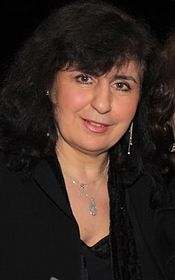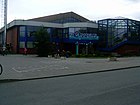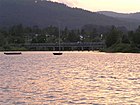Langenbielau
Bielawa lies in the central part of Lower Silesia, along the Bielawica stream in the Owl Mountains region. The town covers an area in excess of 36 square kilometres (14 sq mi).
Bielawa lies at an altitude range of 280 and 964 m above sea level, in the Owl Mountains. The town is a year-round tourist destination; its outdoor attractions include four major hiking trails of varying difficulty in an 80 km (31 sq mi) park, as well as cycling trails and ski lifts.
History
The oldest known mention of Bielawa dates back to 1288, when it was part of fragmented Piast-ruled Poland. Its name is of Polish origin and is derived from the word biela, bila, current Polish biała ("white").
In 1720 the first brick house was built in the village and in 1741 it was captured and afterwards annexed by Prussia. In 1805 Christian Dierig founded a weaving company (Christian Dierig AG). During the Napoleonic Wars, the village was occupied by France. In 1844 it was the site of the Weavers' Uprising, brutally crushed by the Prussians. From 1871 to 1945 it was part of Germany. In 1891 the Dzierżoniów–Bielawa railway line opened. In 1924 Bielawa obtained town rights. During World War II the Germans established the FAL Langenbielau II subcamp of the Gross-Rosen concentration camp in the town. In 1945 it was captured by the Soviets and eventually reintegrated with Poland. Greeks, refugees of the Greek Civil War, settled in Bielawa in the 1950s.
Demographics

Main sights
There are numerous historical buildings in Bielawa. At its center is the 19th-century Neo-Gothic Church of the Assumption with a 101 m tall tower, the third tallest in Poland. Other buildings include a late-Renaissance palace originally built as a fortified manor house; the Church of the Corpus Christi, erected in 1743; and numerous 18th-century Baroque houses that were restored in the 19th and early 20th centuries. It is also a home to a number of medieval penitential crosses.
International relations
Twin towns - sister cities
Bielawa is twinned with:
 Chatham-Kent, Canada
Chatham-Kent, Canada Ciechanów, Poland
Ciechanów, Poland Hronov, Czech Republic
Hronov, Czech Republic Kostelec nad Orlicí, Czech Republic
Kostelec nad Orlicí, Czech Republic Lingen, Germany
Lingen, Germany
Surroundings
- Gola Dzierżoniowska Castle
- Medieval town of Niemcza
- Cistercian monastery at Henryków
Notable people

- Jeremiah Dencke (1725−1795), composer
- Ferdinand Gottlieb Flechtner (1811–1867), German industrialist
- Adolph Franz (1842–1916), German politician
- Friedrich Dierig (1845–1931), German industrialist
- Arthur Philipp Flechtner (1858–1936), Prussian General
- Karl Franz (1881–1967), German politician
- Georg Muschner (1885–1971), German cinematographer
- Walter Möse (1920–1944), Wehrmacht Oberfeldwebel
- Waltraut Engelberg (born 1929), author and wife of Ernst Engelberg
- Johann Alexander Wisniewsky (1929–2012), German industrialist
- Horst Weigang (born 1940), German athlete
- Eleni Tzoka (born 1956), Polish singer
- Aleksandra Kwasniewska (born 1978), Polish singer
- Robert Skibniewski (born 1983), Polish basketball player
- Jarosław Kuźniar (born 1979), Polish journalist and TV presenter
- Janusz Góra (born 1963), Polish footballer
- Art Binkowski (born 1975), Polish-Canadian boxer
- Jarosław Jach (born 1994), Polish footballer
Gallery
-
Parkowa Hill and Bielawa Lake in Bielawa
-
Church of the Assumption of Mary
-
Pension Leśny Dworek
-
Palace
-
Town hall
-
City Park in Bielawa
-
swimming pool "Aquarius" in Bielawa
-
Monument of Pope John Paul II in Bielawa
-
Lake in Bielawa
References
- ^ "Historia miasta". um.bielawa.pl (in Polish). Retrieved 2022-09-07.
- ^ "Local Data Bank". Statistics Poland. Retrieved 2022-09-07. Category K1, group G441, subgroup P1410. Data for territorial unit 0202011.
- ^ "Local Data Bank". Statistics Poland. Retrieved 2022-09-07. Category K3, group G7, subgroup P1336. Data for territorial unit 0202011.
- ^ "Local Data Bank". Statistics Poland. Retrieved 2022-09-07. Category K3, group G7, subgroup P2425. Data for territorial unit 0202011.
- ^ GUS. "Powierzchnia i ludność w przekroju terytorialnym w 2023 roku". stat.gov.pl (in Polish). Retrieved 2023-08-03.
- ^ "Subcamps of KL Gross- Rosen". Gross-Rosen Museum in Rogoźnica. Retrieved 14 March 2020.
- ^ Izabela Kubasiewicz, Emigranci z Grecji w Polsce Ludowej. Wybrane aspekty z życia mniejszości, p. 117 (in Polish)
- ^ "Main Page - Miasta Partnerskie". um.bielawa.pl (in Polish). Bielawa. Retrieved 2020-02-27.
External links
- Official website (in Polish)
- Jewish Community of Bielawa on Virtual Shtetl









